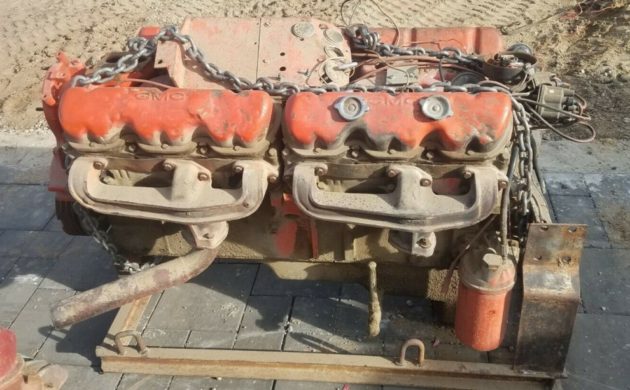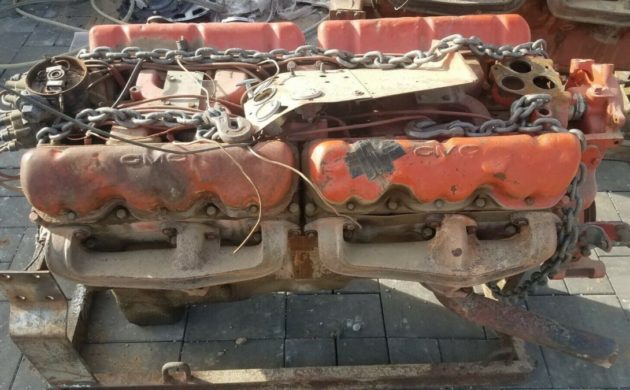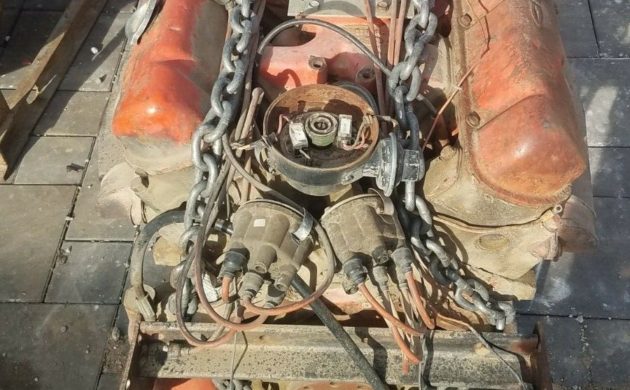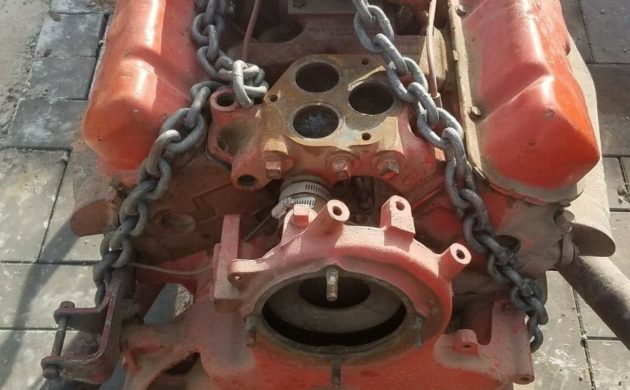Today, V12 engines are largely the preserve of luxury or performance car manufacturers like Ferrari, Rolls-Royce, Lamborghini, and Aston Martin. This has not always been the case, and in the first half of the 1960s, GMC produced a V12 monster that was an engine to be reckoned with. At 702ci, this would nearly have to rate as the biggest of the big-blocks, and you now have the chance to own one of these yourself. The owner has two that he has listed for sale, and the first buyer to pick up their buy can not only choose which engine they would like but can also take their pick of the parts and extras that are also on offer as part of the package. Located in Minden, Nevada, and listed for sale here on eBay. The listing has been set to open at $5,500, but there have been no bids up to this point. There is also a BIN option available, and this has been set at $7,500. These engines have definitely stirred some interest because there are 412 people who are currently watching the listing.
So, if you drop this into your Lamborghini Aventador, two things will certainly happen. The first is that the car will produce a loud groaning sound. The second is that it will almost certainly then collapse in a heap under the enormous weight. To give you a scope of the challenge here, the crankshaft alone weighs in at a healthy 180lbs. Fully dressed, these giants tip the scales at a whopping 1,500lbs. Referred to by GMC as the “Twin-Six,” there can never be any doubt that these engines hailed from the 1960s. This was an era when gas prices were low, and fuel mileage wasn’t even a consideration. The V12 was developed for use in their heavier semis from 1960 until around 1965. However, many also saw duty in industrial applications for powering high-capacity pumps. That is the story behind this pair. They have spent their lives powering high-capacity water pumps on an oil rig, a job for which they are perfectly suited. While engine power is a relatively modest 275hp, they produce a whopping 625lb/ft of torque.
Even though these carried the name “Twin-Six,” the engine wasn’t merely a pair of GMC V6 blocks that had been welded together. The engine block is a single casting, but the engine itself does share something like 60 parts which are interchangeable with the V6. However, there are plenty of parts that are unique to the V12, and some of these carry impressive specifications. The oil pan is a monster and holds a full four gallons of oil. The cylinder heads are held in place by a total of 56 bolts, the wrist pins have a diameter of 1.24 inches, while the engine’s water pump can shift 118 gallons-per-minute to keep things cool. The V12 even features a pair of distributor caps that are operated by a single drive. The bad news with this pair is that while they are complete, they don’t currently turn. Whether this is a problem that could be addressed isn’t clear, but given the fact that spare parts are difficult to source, this has to be a consideration. Having said that, there are specialist companies that can provide a rebuilding service, but once again, this work doesn’t come cheap.
If these GMC engines could be made to run again, it is a bit debatable exactly what you would do with them. Dropping one into your GM pickup probably isn’t going to be viable, but that isn’t to say that it would be impossible. There are a couple of pretty notable street rods that are powered by the 702ci V12, including the Blastolene B702. I’ve also seen a rat rod currently under construction that has been fitted with one of these engines…mid-mounted! Nothing is impossible if your imagination is vivid enough, so if you want to build a wild street custom that would be truly unique, then perhaps one of these engines could be a good starting point.











Nice! Known as the “Thunder V-12”, it was a last gasp , half-baked, I might add, attempt to get truckers over the hill. In the 60’s, diesels were fast becoming the motor of choice, but some folks didn’t trust them, and stayed with gas jobs. While these did provide some added oomph, the biggest downfall was the fuel mileage, 2-3 mpg, in most cases, a diesel could get double that, and still out pull it. These became hot-rodders motor of choice, just because it looks so wild. Just to find one today, much less 2, is pretty rare. You got money to burn for that next project, here you go. They made an awful racket. Imagine sitting behind THIS all day.
https://www.youtube.com/watch?v=hbT4rmlQv9I
If you put this in a rat rod, you’d definitely need some sort of ear protection. I still have a slight ringing in my ears from years of operating Caterpillar D5 farm tractors on a wheat farm in eastern Washington. Plowing, planting wheat, but mostly rod weeding. I used foam ear plugs, but even in a cab it was still pretty noisy.
You gotta remember that when this monster was built the Interstate highway system was still being built, diesels weren’t using turbos (Detroit Diesels don’t count although GMC used them in their “crackerbox” cabovers), diesel fuel was 15 cents versus 19 cents for gas. I can’t see this motor being used for any highway service not involving steep grades. It’s the roadway equivalent of hooking two locomotives together.
What did these use for carburetion?
Stromberg W-Series. At least the ones I worked on had them…
The ultimate boat anchor.
Nah, be a shame to drag this on the bottom of the sea, and I’m surprised you, with a flair for the unusual, would say that ( and that 12 people agree with you) This is an impressive piece of mechanical history, and with so many V6’s made, someone probably still has new parts. Probably no crankshafts around, tho. V12’s and V16’s were nothing new, fire engines had them for years, but I think I read, this was the last American V12 gas motor to be made, and that, to me, is impressive.
Suggestion to the buyer:
1.) Build two crates, open on the ends, sides and top.
2.) After a thorough cleaning, lower each one of these into each one of the fabricated crates.
3.) Cover with a thick piece of safety glass.
You now have 2 end tables for your monstrous garage/man cave or she shed and your friends will be envious of your coolness factor.
Really, is there anything else anyone could do with these?
Good idea, but isn’t a crate that’s “open on the ends, sides and top” just a slab bottom???
That depends on how you build a crate..😆
These were quite the engines back in the day. Keep them full of gas and they would go anywhere or do anything. There were quite a few of them running up the I-15 between Great Falls and up to Calgary. There were a couple of farmers ended up buying some used trucks upon which they mounted boxes and hoists. No shortage of power but they almost needed to take out a second mortgage on their farms to keep them full of fuel. Pon’doreille Gas ran two or three GMC trucks with these. They had a local welding shop fabricate massive road tanks for them. I remember hearing a report that those trucks overall expenses were over $10.00/mile.
The engines ran quite well on propane or natural gas. There was the odd one used to pump irrigation water. This one was used that way…
These were used by USAF in Minuteman ICBM maintenance. They powered the truck that carried the missile to and from the missile sites. The TE (Transporter/Erector) engine. The front of the trailer actually stuck out over the cab of the tractor. So, that’s where some of your tax dollar went. Designed in the late 1950’s and used up until now. No longer classified material. I was stationed at F. E. Warren AFB, just outside Cheyenne, Wyoming for 19.5 years in missile maintenance. Top speed was only about 50 mph and was supposed to be a real handful at that speed. Mostly around 45 mph. And, yeah, not very fuel efficient.
Twin six? They stole that name from Packard; they dubbed their V12’s “twin six” before WW2.
I believe that’s true, more like 2 in-line sixes, except Packard was history when this motor came out.
Back in about the mid 70’s, I attended a big rig drag race. A tractor left his trailers in the parking lot and entered the race. Shannon Bros trucking was a 2 axle with a fifth wheel.
The engines were twin V6, Detroit diesels, married, Allison auto trans. Memory says it turned in the 12’s.
Fastest working truck I ever saw.
Later, I saw a 200 mile oval truck race there. They were raw, not tricked up trucks yet. What a sound
Detroit Diesel made factory V12 and V16 2 stroke diesel engines.
Yes, on the 71 and 92 series the V-12’s were two V-6’s bolted together, and the V-16’s were two V-8’s bolted together end-to-end. DDA also had a “Twin Six” – two 6-71’s side-by-side. Also had a quad package of four 6-71’s driving a single output shaft. The same end-to-end bolt-up was used on the 16V-149.
Detroit did a great job of building modular engines and power packs. I say that it was one of the most adaptable diesel engines made…
Yawn …’While engine power is a relatively modest 275hp, they produce a whopping 625lb/ft of torque.’
Now lets think about something..
Say first v6 locks up or throws a rod..
Hmm what happens to the bolted up attached engine with a hard stop 🛑 saw going full throttle? 😔☠️☠️☠️☠️☠️☠️☠️
Unless its got sheer bolts to free one up your TOAST !!!! It would then make a good high priced low pony non gas guzzling locked up heavy boat anchor though 👍👀
Maybe I an wrong here …but i have seen a few tractor pulls attach two engines for torque and heard them seize loudly and the face of the person the tractor 🚜 too..,
This isn’t two V6s bolted together. It has one block and one crankshaft.
Thanks ! Thats a relief as it looked as two cranks with the blocks welded together.
Still low ponies for price and mods to use to me.
In the early 1960s, there were quite a few drag racers running multiple engines, none as outrageous as TV Tommy Ivo’s four engined/four wheel drive pavement-wrinkler.
These engines, and others like them, were designed for a relatively narrow RPM range. Redline on this was probably less than 4000 RPM. There’s just too much reciprocating mass to chance going faster.
You don’t get it. These engines are just for show ‘n tell now. These were GM’s last ditch failed attempt to compete against the already established big six cylinder gas pots of the day, ie Hall Scott, IH, Buda, etc.
Never seen it done, but TBI might make for 300hp and planet pulling torque. Two Holley 4-barrel carbs would be more likely though.
I worked on a couple of these over the years and they were a challenge but one could still get some good results; you just had to approach them as (2) 351 engines and act accordingly. I had a customer with a 637 V8. He found a guy down in Billings (I believe) who set up intake manifolds to mount 4bbl carbs on them (and I believe he did the same for the large V6s too). My customer installed a 750 Holley and he got rid of a mid-range stumble. I would imagine that a couple of 4bbl carbs on one of these behemoths could give them some extra power but I can assure you that the (2) Stromberg 2bbl units that were already on them had no trouble putting the gas through…
For TBI a holley sniper set up might could be made work. As for what to do with one I’m thinking COE Chevy truck
I’m kind of surprised that GMC didn’t attempt to bring one of these out in diesel form. They had the Toro-Flo engines (478 V6 and 637 V8) which had some marginal success and were a lot more economical than their gas counterparts. I worked on some Toro-Flo engines and while they definitely were no powerhouse, they were reliable. Well the Ambac injection pumps could give some various problems, like fuel leakage around the hydraulic heads and starting difficulties when hot (worn out hydraulic heads). Maybe the General could see the writing on the wall and decided to pull the plug and let the “2-stroke jokes” take over…
I don’t know…those old DD series Detroits put up some impressive numbers in their time. Seems that they sold a boatload of Crackerbox cabovers and they all had Detroits. They’d nearly twist the cab off the frame when pulling 80,000 of steel rolls every time the driver shifted gears.
Hey Dave, I began my trucking career in the 70’s, and I knew some guys that had some runnin’ Detroits, none that I drove, however. One guy had a V12, called the “Buzzin’ Dozen”, in a Freightliner cabover, running around 450 hp. Doesn’t sound like much today, but back then a 290 was the norm. It was a constant headache. I’ve posted this before, but back then, truck owners did what could for more power. This guy bolted a Buick V8 in front of the IH in-line six. Apparently, it worked rather well.
https://www.hemmings.com/blog/2014/09/08/and-thats-the-truth-frank-gripps-twin-engine-diamond-t/
Those Detroits made a name for themselves in a hurry. Despite being the brunt of a lot of trucker jokes they earned an enviable reputation. I never encountered a 12 cylinder in trucks but I sure saw a lot of 6-71 and 8V-71 versions. They held their own as long you kept your foot on the lumber…
It was called, “keep the needle against the pin”, referring to, keep the revs up. If they dropped even a few hundred rpms, a downshift, to keep the tach needle against the pin stop, was in order. It’s one of the reasons the 13 speed RoadRanger transmission was created, solely for Detroit motors.
I learn so much from you motor heads that have either lived this stuff or been around it during your lives. Thanks for sharing and educating those of us who haven’t.
What you said, Rough Diamond-a lot of good, smart people here willing to share.
Nevadahalfrack
Yep! Well said. This is another example of learning something I’m so interested in from those who know their stuff. I’ve never seen or heard of these things, but as usual, someone on this site has!
He’s a bit humble, but geomechs is the real asset here. He’s forgotten more than I know.
Come on, Howard, my head is big enough. Tell you what: In my career I’ve heard the term: EXPERT. I’m far from that, unless the word is used in the proper context. ‘Ex’ is a has-been, and ‘Spurt’ is a drip under pressure…
Can’t sleep, eh? Sorry, if it’s a load of junk engine blocks on a van trailer grossing 90K lbs. and it needs to get to Chicago around a scale, I’m your man. When it comes to nuts and bolts that hold these things together, you da’ man. That’s something to be proud of. I’ve said it before, but bears repeating, if it wasn’t for folks like you that kept these beasts running, I couldn’t have done my job. Ripple effect to that, is no strawberries at Walmart, or whatever. An important spoke in the wheel, for sure.
Thanks, my friend. I think Alabama said it all in “40 Hour Week.” A truck breaks down and needs parts; it takes another truck to deliver the parts. It takes another troop to keep the roads passable. And someone has to deliver the produce. I have few regrets over the choices I’ve made although this ex—spurt still gets a little morose when he watches the mechanics going to work…
Seagrave & ALF made gas V12 engines until quite late on?
I think the Seagrave V-12 was actually based on a Pierce-Arrow engine.
Yes, the Seagrave 12 & 8 Motors were made on the tooling and design from Pierce Arrow when they went caput. The LaFrance motor was Lycoming design another big supplier to independents . Both Seagrave & LaFrance also had LARGER V 12s of their own design for large pumpers and ladder trucks.
The GMC V 12 was a repower motor for Portland Or Fire in the early sixties.
I drove a GMC cab-over tractor with one of those engines back in the ’80s. YES, it made lots of noise. My Father would buy these obsolete unsafe trucks for the business and make me drive them. I also had a 1953 single axle IH with a 28′ trailer and vacuum brakes. My favorite was a 1970 single axle Chevy Truck Tractor with a 427 in it. That Truck had a great sound.
Like the old 6V53 318ci. jimmy. just run them up on the gov. till they started to crap out, then shift. Worked good. But 2 stroke Detroit diesels have nothing to do with these old GMC gas engines. Later………………………….JIMMY
Really cool find and reading everyone’s posts really makes me believe that this should be saved for its historical value!! Such a good world we had in those days of manufacturing taking chances in research and development!! I couldn’t even begin to think of what car to put this under its hood but it should be preserved!!!
At one of the last Good Guys shows in Indy, 7-8 years ago, fellow had an extended nose, early Sixties GMC pickup with a V-12 as the powerplant. Similar to the first two examples here, but better finished.
http://6066gmcguy.com/V12powered.html
Rat rod fer shr, rebuild, leave it rough.
Yep, rat rod, maybe with plaid valve covers?
http://6066gmcguy.com/GMCplaid.html
Great article and better comments .
L.A.P.D.’s Air Support Division had one of these , a helicopter fuel tanker .
It was in service in the San Fernando Valley into the 2000’s….
Low miles, never dented / abused, all original and ran great but sucked up fuel like nothing else .
Jimmy two – smoke Diesels were very good too but polluted like mad and those who drove or worked on them called them “Road Oilers” back in the day because they pissed out so much oil .
-Nate
I have a real hankering for one of these. Hav been looking half seriously since before your thread started. I have a feeling that this developed in a large part because the military needed the missile carrier that would start and run no matter what at 40 below. GM being on the good side of Uncle Sam got the go ahead and was allowed to use the tooling for their own purposes too. Just my theory but military was the most likely to need an engine that damn the torpedoes would work no matter what.